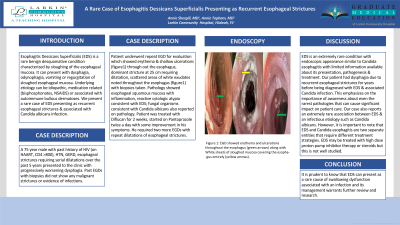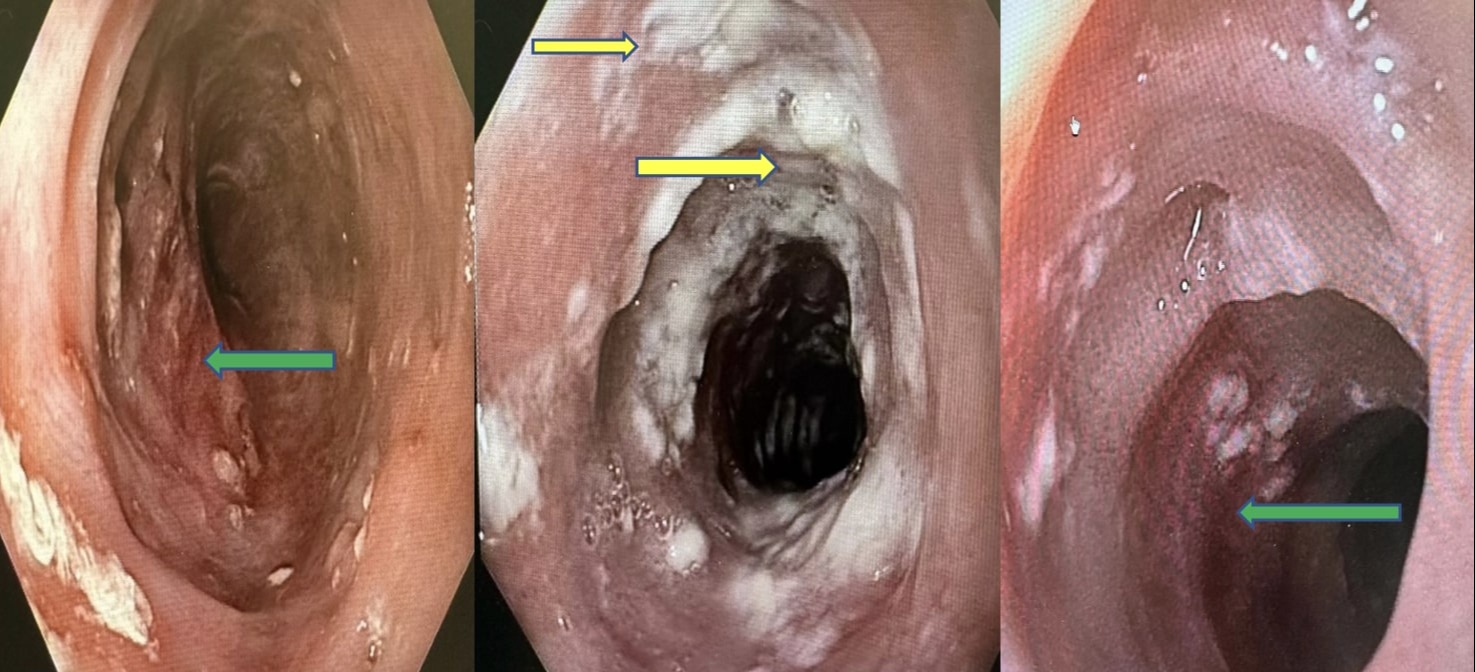Sunday Poster Session
Category: Esophagus
P0489 - A Rare Case of Esophagitis Dessicans Superficialis Presenting as Recurrent Esophageal Strictures
Sunday, October 22, 2023
3:30 PM - 7:00 PM PT
Location: Exhibit Hall

Has Audio

Annie Shergill, MD
Larkin Community Hospital
Miami, FL
Presenting Author(s)
Annie Shergill, MD1, Annie Topham, MD2
1Larkin Community Hospital, Miami, FL; 2Larkin Community Hospital, Palm Springs Campus, Miami, FL
Introduction: Esophagitis Dessicans Superficialis (EDS) is a rare benign desquamative condition characterized by sloughing of the esophageal mucosa. It can present with dysphagia, odynophagia, vomiting or regurgitation of sloughed esophageal mucosa. Underlying etiology can be idiopathic, medication related (bisphosphonates, NSAIDS) or associated with autoimmune bullous dermatoses. We present a rare case of EDS presenting as recurrent esophageal strictures & associated with Candida albicans infection.
Case Description/Methods: A 75 year male with past history of HIV (on HAART, CD4 >800), HTN, GERD, esophageal strictures requiring serial dilatations over the past 5 years presented to the clinic with progressively worsening dysphagia. Past EGDs with biopsies did not show any malignant strictures or evidence of infections. Patient underwent repeat EGD for evaluation which showed erythema & shallow ulcerations (figure1) through out the esophagus, dominant stricture at 25 cm requiring dilatation, scattered areas of white exudates noted throughout the esophagus (figure1) with biopsies taken. Pathology showed esophageal squamous mucosa with inflammation, reactive cytologic atypia consistent with EDS; fungal organisms consistent with Candida albicans also reported on pathology. Patient was treated with Diflucan for 2 weeks, started on Pantoprazole twice a day with some improvement in his symptoms. He required two more EGDs with repeat dilatations of esophageal strictures. .
Discussion: EDS is an extremely rare condition with endoscopic appearance similar to Candida esophagitis with limited information available about its presentation, pathogenesis & treatment. Our patient had dysphagia due to recurrent esophageal strictures for years before being diagnosed with EDS & associated Candida infection. This emphasizes on the importance of awareness about even the rarest pathologies that can cause significant impact on patient care. Our case also reports an extremely rare association between EDS & an infectious etiology such as Candida albicans. However, it is important to note that EDS and Candida esophagitis are two separate entities that require different treatment strategies. EDS may be treated with high dose proton pump inhibitor therapy or steroids but this area requires further review & research.

Disclosures:
Annie Shergill, MD1, Annie Topham, MD2. P0489 - A Rare Case of Esophagitis Dessicans Superficialis Presenting as Recurrent Esophageal Strictures, ACG 2023 Annual Scientific Meeting Abstracts. Vancouver, BC, Canada: American College of Gastroenterology.
1Larkin Community Hospital, Miami, FL; 2Larkin Community Hospital, Palm Springs Campus, Miami, FL
Introduction: Esophagitis Dessicans Superficialis (EDS) is a rare benign desquamative condition characterized by sloughing of the esophageal mucosa. It can present with dysphagia, odynophagia, vomiting or regurgitation of sloughed esophageal mucosa. Underlying etiology can be idiopathic, medication related (bisphosphonates, NSAIDS) or associated with autoimmune bullous dermatoses. We present a rare case of EDS presenting as recurrent esophageal strictures & associated with Candida albicans infection.
Case Description/Methods: A 75 year male with past history of HIV (on HAART, CD4 >800), HTN, GERD, esophageal strictures requiring serial dilatations over the past 5 years presented to the clinic with progressively worsening dysphagia. Past EGDs with biopsies did not show any malignant strictures or evidence of infections. Patient underwent repeat EGD for evaluation which showed erythema & shallow ulcerations (figure1) through out the esophagus, dominant stricture at 25 cm requiring dilatation, scattered areas of white exudates noted throughout the esophagus (figure1) with biopsies taken. Pathology showed esophageal squamous mucosa with inflammation, reactive cytologic atypia consistent with EDS; fungal organisms consistent with Candida albicans also reported on pathology. Patient was treated with Diflucan for 2 weeks, started on Pantoprazole twice a day with some improvement in his symptoms. He required two more EGDs with repeat dilatations of esophageal strictures. .
Discussion: EDS is an extremely rare condition with endoscopic appearance similar to Candida esophagitis with limited information available about its presentation, pathogenesis & treatment. Our patient had dysphagia due to recurrent esophageal strictures for years before being diagnosed with EDS & associated Candida infection. This emphasizes on the importance of awareness about even the rarest pathologies that can cause significant impact on patient care. Our case also reports an extremely rare association between EDS & an infectious etiology such as Candida albicans. However, it is important to note that EDS and Candida esophagitis are two separate entities that require different treatment strategies. EDS may be treated with high dose proton pump inhibitor therapy or steroids but this area requires further review & research.

Figure: Figure 1: EGD showed erythema and ulcerations throughout the esophagus (green arrows) along with white sheets of sloughed mucosa covering the esophagus entirely (yellow arrows).
Disclosures:
Annie Shergill indicated no relevant financial relationships.
Annie Topham indicated no relevant financial relationships.
Annie Shergill, MD1, Annie Topham, MD2. P0489 - A Rare Case of Esophagitis Dessicans Superficialis Presenting as Recurrent Esophageal Strictures, ACG 2023 Annual Scientific Meeting Abstracts. Vancouver, BC, Canada: American College of Gastroenterology.
